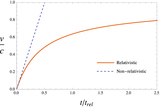Image Details

Caption: Figure 3.
A plot of the various powers in Equations (16)–(18). Initially, the spacecraft velocity is low and Doppler effects are small. Hence, the power in the backward photon column (BPC) dominates. As the spacecraft speeds up, the power on the sail decreases and the reflected photons get increasingly redshifted. This causes the power in the BPC to decrease and the power in the FPC to increase. At low velocities, spacecraft power increases, as the increased efficiency per collision (Equation (15)) outweighs the decreasing flux on the sail. At higher speeds, the decreasing flux dominates and the spacecraft power drops to 0. At ﹩\beta =\sqrt{2}-1﹩, these competing effects maximize the spacecraft power. At β = 1/3, the powers in all three components are equal. For large β, the DE system’s power goes into elongating the FPC instead of propelling the spacecraft. Diffraction effects are ignored here but discussed in Section 4.
Copyright and Terms & Conditions
© 2018. The American Astronomical Society. All rights reserved.









